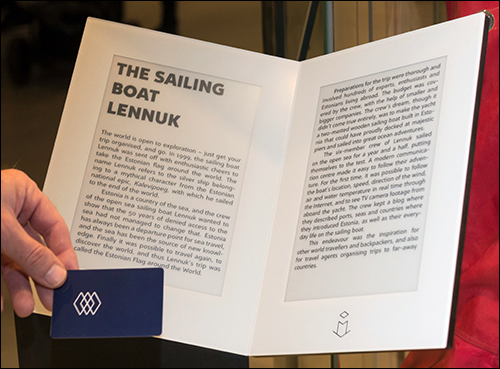At its new home near the city of Tartu, the Estonian National Museum has installed more than 600 RFID-enabled signs produced by Taiwan-based E Ink. Each museum visitor is provided with an RFID-enabled card that prompts the display of exhibit-related information in his or her chosen language.
Currently, the options are limited to Estonian, English (spoken mostly by foreigners, who comprise roughly 5 percent of the visitors) and Russian (spoken by Estonia’s large Russian minority). However, the museum hopes to soon add additional languages, such as Finnish, Latvian, French, Italian and possibly German. Visitors can pick up the cards—made with NXP Semiconductors Icode SLIX 13.56 MHz RFID chips complying with the Near Field Communication (NFC) Type 5 and ISO 15693 standards—at the museum’s entrance and return them when they leave.

The glass-walled museum, which officially opened its doors to the public on Oct. 1, 2016, is 356 meters (1,168 feet) in length and rises up like a glittering whale from the flat land that surrounds it—land that, until recently, was occupied by a Soviet airbase. The museum’s 6,100 square meters (65,700 square feet) of exhibition space provides a glimpse of Estonians’ everyday lives during different periods. Interactive displays make it possible to observe what Estonian homes look like, explore Estonian cuisine, and learn about local dress, language and customs.
The signs measure 32 inches, 9.7 inches or 6.8 inches diagonally. The 32-inch signs are used to guide visitors around the museum, while the smaller versions describe artifacts. Each sign features E Ink’s black-and-white bistable electronic paper display (EPD). The term “bistable” means that the image on an E Ink screen will be retained even when all power sources are removed. This enables the sign to consume power only when the text is changed.
The museum chose electronic signage instead of conventional printed signs because it wanted its exhibits to support as many languages as possible, and to provide visitors with a personalized experience. In addition, this helps the museum to go digital, while at the same time providing a natural, less-distracting appearance than other displays, such as LEDs. The ticket system has worked well thus far, the museum reports, and has been well received by both visitors and staff members.
The 32-inch signs are equipped with low-power, high-definition, high-resolution displays (2,560 by 1,440 pixels) and contain two RFID readers. The 9.7-inch and 6.8-inch versions contain one RFID reader apiece and do not exceed 2 millimeters (0.08 inch) in thickness and 100 grams (0.23 ounce) in weight, which keeps their footprint to a minimum and allows for easy display. Artec Design incorporated the readers, made with an NXP reader IC, into the signs’ main electronic boards.
The signs can read not only RFID cards complying with the NFC Type 5 and ISO 15693 standards, but also those made with NXP’s Mifare Classic, Ultralight and DESfire chips, which comply with the ISO 14443 standard and are faster to read but have a shorter reading range. Artec opted for cards that comply with the NFC Type 5 technology, however, since they offer a longer read range, as some of the signs are located on the other side of glass walls.
Harit Doshi, who heads E Ink’s signage business, says that this was one of the first instances in which E Ink signs have been commercially deployed in large scale at a museum. A company called 3 + 1 Architects developed the concept for the signs, while Artec Design developed the full solution and was responsible for the design of the RFID software and hardware, as well as the readers’ integration.

